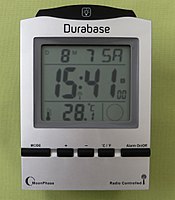
Digital clock
A digital clock displays the time digitally (i.e. in numerals or other symbols), as opposed to an analogue clock.
This article is about the appliance. For timing reference for digital audio, see Word clock.Digital clocks are often associated with electronic drives, but the "digital" description refers only to the display, not to the drive mechanism. (Both analogue and digital clocks can be driven either mechanically or electronically, but "clockwork" mechanisms with digital displays are rare.)
History[edit]
The first digital pocket watch was the invention of Austrian engineer Josef Pallweber[1] who created his "jump-hour" mechanism in 1883. Instead of a conventional dial, the jump-hour featured two windows in an enamel dial, through which the hours and minutes are visible on rotating discs. The second hand remained conventional. By 1885, Pallweber mechanism was already on the market in pocket watches by Cortébert and IWC; arguably contributing to the subsequent rise and commercial success of IWC. The principles of Pallweber jump-hour movement had appeared in wristwatches by the 1920s (Cortébert) and are still used today (Chronoswiss Digiteur). While the original inventor did not have a watch brand at the time, his name has since been resurrected by a newly established watch manufacturer.[2]
Plato clocks used a similar idea but a different layout. These spring-wound pieces consisted of a glass cylinder with a column inside, affixed to which were small digital cards with numbers printed on them, which flipped as time passed. The Plato clocks were introduced at the St. Louis World Fair in 1904, produced by Ansonia Clock Company. Eugene Fitch of New York patented the clock design in 1903.[3]
Thirteen years earlier, Josef Pallweber had patented the same invention using digital cards (different from his 1885 patent using moving disks) in Germany (DRP No. 54093).[4]
The German factory Aktiengesellschaft für Uhrenfabrikation Lenzkirch made such digital clocks in 1893 and 1894.[5]
The earliest patent for a digital alarm clock was registered by D. E. Protzmann and others on October 23, 1956, in the United States.[6] Protzmann and his associates also patented another digital clock in 1970, which was said to use a minimal amount of moving parts. Two side-plates held digital numerals between them, while an electric motor and cam gear outside controlled movement.[3]
In 1970, the first digital wristwatch with an LED display was unveiled on the Johnny Carson Show, although it was not released until 1972.[7] Called the Pulsar, and produced by the Hamilton Watch Company, this watch was hinted at two years prior when the same company created a non-function digital watch prop (with a main analogue face but a secondary digital display) for Kubrick's 2001: A Space Odyssey.[8]
Construction[edit]
Digital clocks typically use the 50 or 60 hertz oscillation of AC power or a 32,768 hertz crystal oscillator as in a quartz clock to keep time. Most digital clocks display the hour of the day in 24-hour format; in the United States and a few other countries, a commonly used hour sequence option is 12-hour format (with some indication of AM or PM). Some timepieces, such as many digital watches, can be switched between 12-hour and 24-hour modes. Emulations of analog-style faces often use an LCD screen, and these are also sometimes described as "digital".



